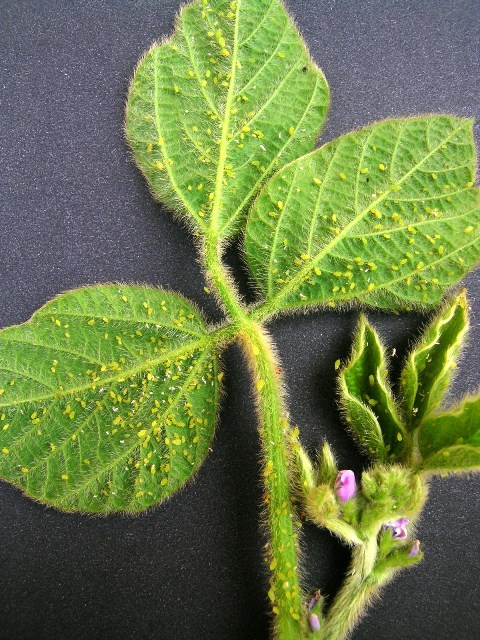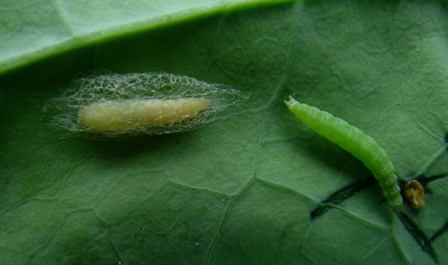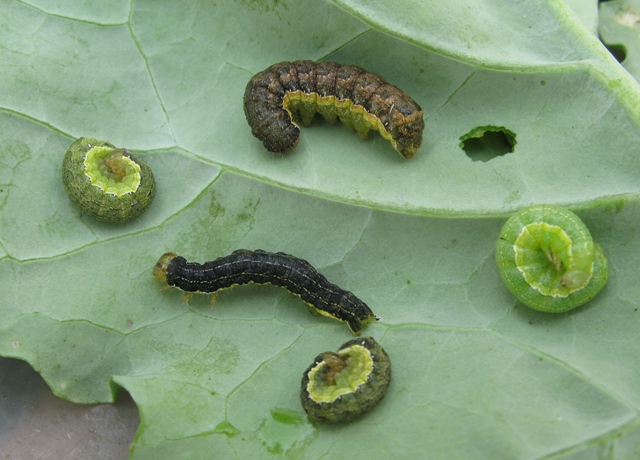Manitoba Insect & Disease Update
Issue 12: August 9, 2017
Summary
Insects:
Soybean aphids continue to be a concern in some fields, with insecticide applications having occurred. In some soybean fields natural enemy populations seem to be building in response to the soybean aphids.
Bertha armyworms are being monitored, and high levels of larvae have been reported from some canola fields in western Manitoba. Several fields have had insecticide applications to control bertha armyworms. So far high populations have been west of the Holland-Austin area to the Saskatchewan border.
Soybean Aphids: Effects of temperature and Plant Staging
Effect of temperature on soybean aphids: As with other insects, soybean aphids have a temperature range where development is optimum, with development being slower below and above the optimum range. For soybean aphid the temperature for optimum growth is around 27C. At lower temperatures development will be slower. At the other extreme, in experiments where soybean aphids were kept at high temperatures, nymphs did not complete development at 35C and died within 11 days (J. Econ. Entomol. 2004: 854-861).

Figure 1. Soybean aphids. The white specks are the shed skins from aphids that have molted.
Spider mites in Soybeans
In a few soybean fields, feeding from spider mites and yellowing of leaves has been noticed, mainly around the edges of the field. There is often a strong edge effect with spider mites on soybeans.
Spider mite populations are often higher when conditions have been hot and dry for a sustained period of time, and populations can change substantially after heavy rains. So if you have been noticing what appears to be feeding from spider mites on soybean plants, and the area has had some recent rain, make sure to look for the mites and see what the current population is like. Spider mites are small (about 0.4 mm), so tapping the leaves over something that the mites can easily be seen on may help in determining their presence and levels.
The stages of soybeans that are most susceptible to spider mites are the R4 (full pod) through R5 (beginning seed – when seeds are filling) stages. Once the soybeans reach R6 (full seed or green bean stage) the feeding from spider mites will have less impact on yield.
Bertha Armyworm: Length of Larval Stages
How long bertha armyworm remains in the larval stage depends on the temperature. Lab studies determined that at a constant temperature of 20C it took 30 days to complete the 6 larval stages, at 24C it took 21 days, and at 28C it took 18 days (The Canadian Entomologist. 1976: 1339-1344). So with the fluctuating temperatures we get in late-July and August I would expect it to take somewhere around 3 weeks for the larvae to pass through their 6 larval stages. The last larval stage (instar 6) lasts the longest, lasting for 8 days at 24C. However, when they get into the later part of this stage they are not feeding and getting ready to transform into a pupa.
Lifecycle of diamondback moth
Over the past week many of the larvae of diamondback moth have turned into pupae. Some have been wondering how long it will take until we see larvae again. The table below shows how long diamondback moth spends in each stage.
Table 1. Duration of development (days) for various stages of diamondback moth at 20 and 25ºC
Duration of development (days) | ||||||||
|
||||||||
Temp (ºC) |
Egg |
1 |
2 |
3 |
4 |
Egg & larva |
Pupa |
Total |
20 |
5.5 |
3.8 |
2.6 |
2.2 |
3.3 |
16.9 |
6.7 |
23.6 |
25 |
3.0 |
2.0 |
1.9 |
1.6 |
2.9 |
11.1 |
5.1 |
16.2 |
Some of the earlier seeded canola may be beyond where diamondback moth is a concern by the time the next generation of larvae appear, but in some of the later-seeded canola diamondback moth larvae may be something to continue to monitor. As canola matures it will become a less enticing host for diamondback moth to lay eggs on, so I am not expecting to see as high levels of larvae on canola as we had with the last generation.

Figure 2. Diamondback moth pupa (left) and larva (right).
Flea Beetles: Is Feeding on Pods Economical
Flea beetles are starting to appear in many canola fields that are in the podding stages. Some have been asking how economical this can potentially be to the canola. A study was done at Agriculture and Agri-Food Canada in Saskatoon to answer this question. The study concluded that:
Flea beetle feeding on canola in late-summer is rarely an economic concern. Flea beetle feeding that occurs when seeds in lower pods of canola are at the green stage or beyond is unlikely to affect seed yields regardless of the infestation rate of flea beetles. Even when seeds are translucent to green, numbers higher than 100 flea beetles per plant, and for some cultivars higher than 350 per plant, may be necessary to cause significant yield reductions (Soroka and Grenkow. Can. J. Plant Sci. 2012: 97-107).
Insect Monitoring Programs
Grasshopper Survey: A reminder for those participating in the grasshopper survey, that counts are done during August, when the majority of grasshoppers are in the adult stage. Even if grasshopper levels are low in your area, this is valuable data for the survey. So don't not do counts in a region because grasshopper levels are low. The purpose of the survey is to map what average grasshopper levels are like in a region, so waiting until a high level is encountered to do an assessment would bias the data.
Agronomists and farmers who would also be interested in estimating grasshopper numbers in the fields they are in and have this information included in the survey are encouraged to see the survey protocol for more details of the survey and where to send data. Estimates of grasshopper levels can be collected during regular farm visits.
"Estimates" of grasshopper populations is stressed as it will not be possible to accurately count grasshoppers along a field edge or ditch area as they will be moving around as you get near the area of the count. But estimate of what is present gives us some idea of the relative numbers that are present in different areas.
Data from the survey, along with weather data during the egg laying period of the grasshoppers, is used to produce a forecast for 2018.
The protocol and data sheet for the grasshopper survey is at: http://www.gov.mb.ca/agriculture/crops/insects/mb-grasshopper-survey.html
"Estimates" of grasshopper populations is stressed as it will not be possible to accurately count grasshoppers along a field edge or ditch area as they will be moving around as you get near the area of the count. But estimate of what is present gives us some idea of the relative numbers that are present in different areas.
Data from the survey, along with weather data during the egg laying period of the grasshoppers, is used to produce a forecast for 2018.
The protocol and data sheet for the grasshopper survey is at: http://www.gov.mb.ca/agriculture/crops/insects/mb-grasshopper-survey.html
Insect Identification Quiz
Which of the caterpillars in the photo below are bertha armyworm?

Answer: These are all bertha armyworm. As they mature, their color becomes variable. Some remain green, but many may become brown or velvety black. At maturity, the larvae are about 4 cm (1.5 inch) long.
----------------------------------------------------------------------------------------------------------------------
Compiled by:
John Gavloski, Entomologist Holly Derksen, Field Crop Pathologist
Manitoba Agriculture Manitoba Agriculture
Phone: (204) 750-0594 Phone: (204) 750-4248
To report observations on insects or plant pathogens that may be of interest or importance to farmers and agronomists in Manitoba, please send messages to the above contacts.
To be placed on an E-mail list so you will be notified immediately when new Manitoba Insect and Disease Updates are posted, please contact John Gavloski at the address or numbers listed above.
